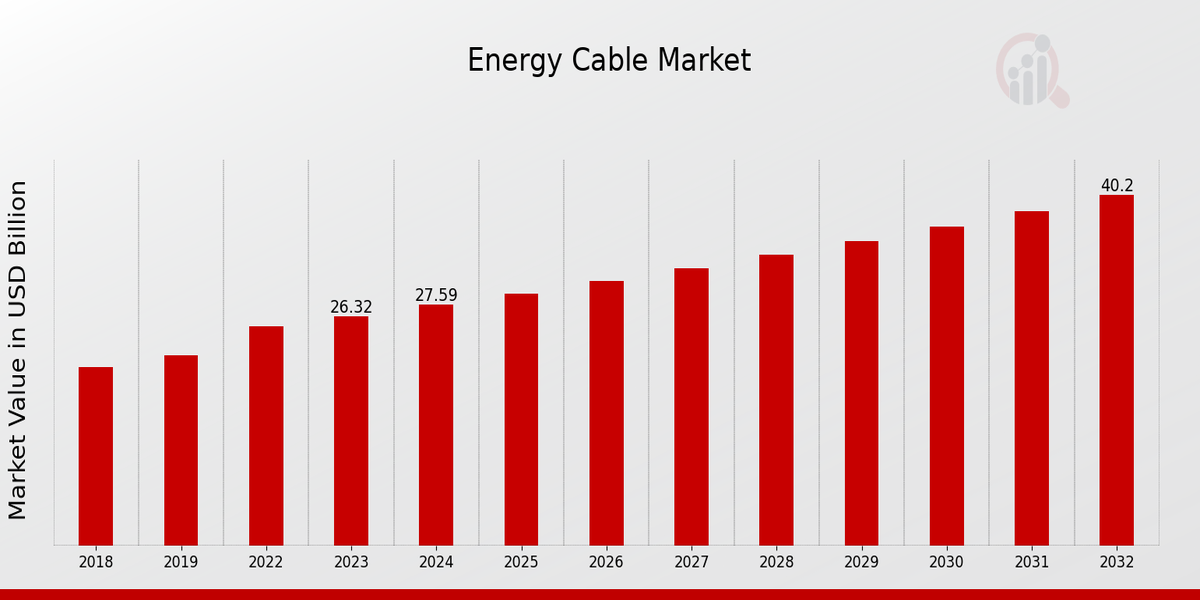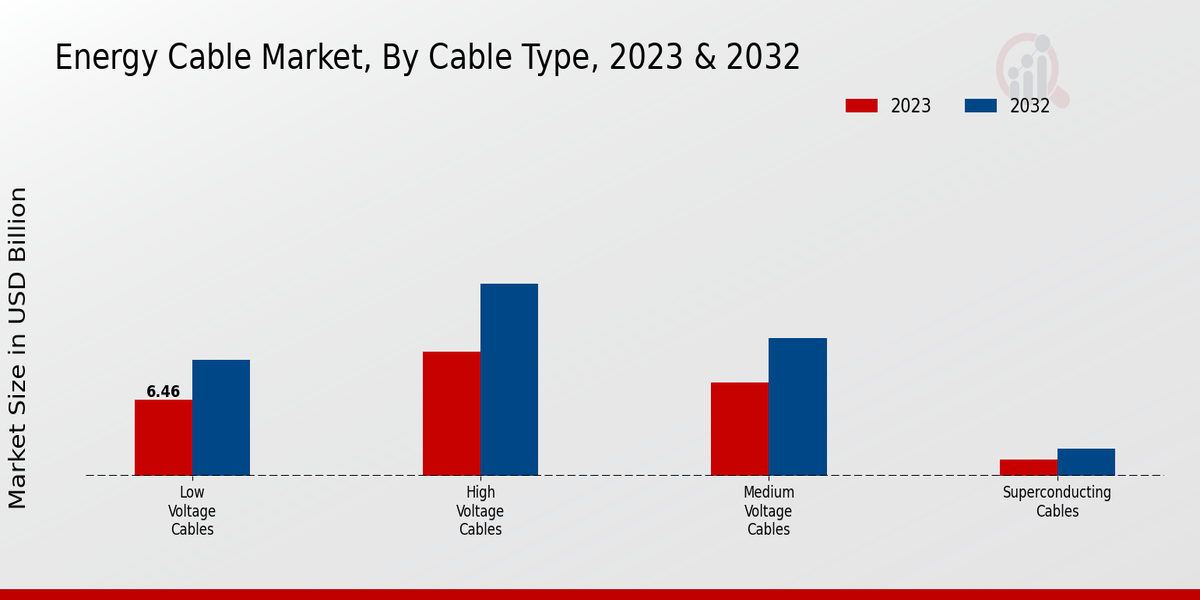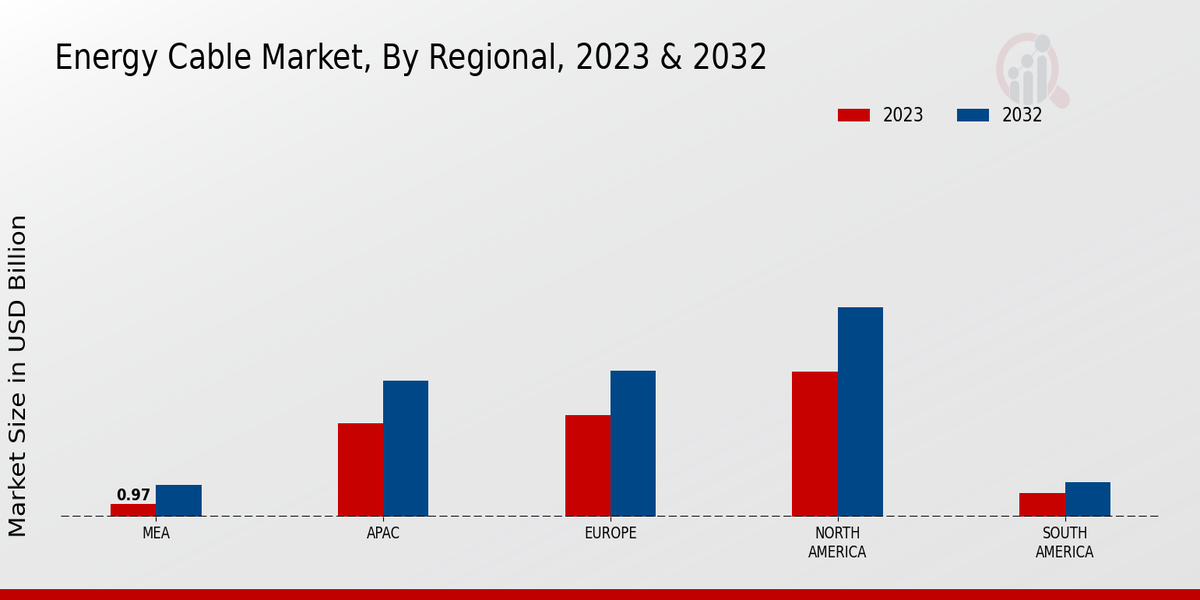Global Energy Cable Market Overview
As per MRFR analysis, the Energy Cable Market Size was estimated at 25.11 (USD Billion) in 2022. The Energy Cable Market Industry is expected to grow from 26.32 (USD Billion) in 2023 to 40.2 (USD Billion) by 2032. The Energy Cable Market CAGR (growth rate) is expected to be around 4.82% during the forecast period (2024 - 2032).
Key Energy Cable Market Trends Highlighted
The Energy Cable Market is experiencing significant growth driven by several key market drivers. The increasing demand for renewable energy sources, particularly wind and solar power, is creating a need for advanced transmission solutions. As countries worldwide strive to enhance their energy infrastructure and reduce carbon emissions, the incorporation of energy cables becomes crucial in connecting remote renewable energy facilities to urban centers. Furthermore, advancements in technology are leading to the development of high-performance cables, which offer better efficiency, durability, and capacity to handle increased power loads.
Government policies and investments in smart grid technologies are also fueling market momentum as they promote the integration of energy cables into modern energy networks. Opportunities within this sector continue to expand, particularly in developing regions where energy access is limited. The increasing urbanization and demand for electrification in these areas provide a fertile ground for investment in energy cable projects. Additionally, the shift towards electric vehicles is creating a burgeoning need for robust charging infrastructure, which will further drive the demand for specialized cables.
The growing focus on sustainability is encouraging manufacturers to innovate in materials and production processes, paving the way for environmentally friendly options that appeal to eco-conscious consumers.
In recent times, there has been a noticeable trend toward digitalization within the energy sector. Smart cables equipped with monitoring technology are emerging to provide real-time data on performance, thereby enhancing maintenance and optimizing energy distribution. The integration of these intelligent systems is expected to revolutionize how energy cables operate, leading to greater reliability and efficiency. Overall, the Energy Cable Market is poised for dynamic growth, driven by evolving technologies, increasing investments in infrastructure, and a collective push towards cleaner energy solutions.

Source: Primary Research, Secondary Research, Market Research Future Database and Analyst Review
Energy Cable Market Drivers
Rising Demand for Renewable Energy Sources
The shift towards renewable energy sources is one of the most significant drivers propelling the growth of the Energy Cable Market Industry. Governments and organizations are increasingly investing in renewable energy projects such as wind, solar, and hydropower initiatives. This transition not only aims at reducing the dependence on fossil fuels but also targets greenhouse gas emissions reduction. As these renewable energy sources proliferate, there is a heightened need for advanced energy cables that can efficiently transmit electricity across vast distances.
The enhancement of grid infrastructure to accommodate the influx of renewable energy necessitates the deployment of upgraded and innovative cabling solutions. The Energy Cable Market Industry is seeing an upsurge in demand for cables that can withstand environmental challenges while ensuring minimal energy loss during transmission. Therefore, the concerted efforts towards establishing a sustainable energy ecosystem will drive the market for energy cables forward, fostering advancements in technology and infrastructure required to harness and distribute clean energy effectively.
Investment in Smart Grid Technology
The integration of smart grid technology presents a dynamic avenue for growth in the Energy Cable Market Industry. Smart grids facilitate real-time monitoring and management of energy transmission, leading to enhanced operational efficiency and reliability. As more utilities invest in smart grid solutions, the demand for high-performance energy cables that support these technologies will escalate. The ability of smart grids to incorporate renewable energy sources necessitates advanced cabling systems that can handle varied energy loads and mitigate issues related to energy loss and outages. Therefore, the proliferation of smart grid initiatives will significantly uplift the energy cable industry.
Increasing Urbanization and Infrastructure Development
As urbanization accelerates worldwide, the need for robust electrical infrastructure becomes critical. The Energy Cable Market Industry is poised for growth as cities expand, necessitating the installation of new energy cabling systems to support increased power consumption. Along with urban expansion, infrastructure development projects such as transportation, housing, and commercial establishments require efficient energy transmission solutions. The mounting construction activities drive the demand for energy cables that can provide a reliable and safe power supply to new developments.
Consequently, this urban and infrastructure growth serves as a potent driver for the energy cable market, ensuring the continued evolution and modernization of electrical networks.
Energy Cable Market Segment Insights:
Energy Cable Market Cable Type Insights
The Global Energy Cable Market, valued at 26.32 USD Billion in 2023, encompasses various cable types that play pivotal roles in energy transmission. Among these, High Voltage Cables hold a significant position, achieving a value of 10.56 USD Billion in 2023 and projected to reach 16.36 USD Billion by 2032. These cables are crucial for long-distance electricity transmission, enabling utilities to transfer large amounts of power more efficiently, thus playing a dominant role in the market due to the growing demand for renewable energy sources and expansion of electricity networks.
In contrast, Medium Voltage Cables, valued at 7.92 USD Billion in 2023 and expected to grow to 11.73 USD Billion by 2032, primarily facilitate distribution in urban and suburban areas, making them significant for infrastructural development. The majority holding of these cables in residential and commercial applications underscores their essential function in ensuring reliable power supply in densely populated areas.
Low Voltage Cables also play a critical role, valued at 6.46 USD Billion in 2023 and rising to 9.84 USD Billion by 2032, primarily used for final connections in electrical systems. Their significance stems from the increasing need for safe and efficient electrical installations in residential and commercial buildings. Meanwhile, Superconducting Cables, with a valuation of 1.38 USD Billion in 2023, showing growth to 2.27 USD Billion by 2032, represent a newer technology that minimizes energy loss during transmission and therefore holds promise for future energy systems.
Although they currently hold a smaller market share, their innovative capacity positions them as a noteworthy opportunity within the Global Energy Cable Market.
Overall, these statistics reflect a robust growth trajectory driven by the need for enhanced power transfer efficiency, technological advancements, and increasing urbanization, with each cable type contributing uniquely to the broader market dynamics reflecting the Energy Cable Market segmentation.

Source: Primary Research, Secondary Research, Market Research Future Database and Analyst Review
Energy Cable Market Material Insights
The Global Energy Cable Market, valued at 26.32 billion USD in 2023, is experiencing notable developments in the Material segment. This segment encompasses various materials such as Copper, Aluminium, Fiber Optic, and Composite Materials, each playing a vital role in the energy sector. Copper is recognized for its excellent conductivity, facilitating efficient energy transfer, while Aluminium offers a lightweight, cost-effective alternative that caters to specific applications. Fiber optic cables are becoming increasingly significant due to their capabilities in high-speed data transmission, making them essential in smart grid systems.
Meanwhile, Composite Materials are gaining traction for their durability and resistance to environmental factors, meeting the growing demand for sustainable energy solutions. The proliferation of renewable energy sources and the expanding need for enhanced grid infrastructure are fueling market growth. However, challenges such as fluctuating raw material prices and environmental regulations may affect market dynamics. Overall, the Energy Cable Market data reflects a robust trajectory, bolstered by increasing energy demands and technological advancements, showcasing diverse opportunities across its segments.
Energy Cable Market Application Insights
The Energy Cable Market Market, valued at 26.32 USD Billion in 2023, showcases a diverse range of applications that play a crucial role in its overall dynamics. Among these, Power Distribution is a significant segment, as it facilitates the transmission of electricity from generation sources to end-users, which is vital for urban development. Renewable Energy Generation also represents a major focus, driven by the global shift towards sustainable energy sources, with increasing investments enhancing infrastructure for solar and wind energies.
Telecommunications remains essential for ensuring seamless data transmission, supporting the growing demand for connectivity across various sectors. Industrial Applications also hold importance, as industries rely on robust energy cables for enhanced operational efficiency. The segmentation of the Energy Cable Market reflects the expanding need for effective energy solutions, underpinned by trends toward electrification and a growing emphasis on green technologies. The market growth is influenced by emerging opportunities and the ongoing shift in energy consumption patterns, posing both challenges and prospects for industry stakeholders.
Energy Cable Market Installation Type Insights
The Energy Cable Market is projected to be valued at 26.32 USD Billion in 2023, highlighting the market's ongoing growth driven by increasing investments in renewable energy infrastructure and the need for enhanced transmission capabilities. The Installation Type segmentation reveals a diverse landscape, prominently featuring Overhead, Underground, Submarine, and Integrated Systems. The Overhead segment typically holds a majority share due to its cost-effectiveness and speed of installation, making it an attractive choice for energy transmission.
Meanwhile, the Underground segment is gaining importance, primarily for its ability to minimize environmental impact and enhance safety. Submarine installations are essential for connecting offshore renewable energy sources to the grid, thus supporting the global shift towards sustainable energy. Integrated Systems have emerged as a significant component, streamlining the integration of various technologies and improving overall efficiency. The diversity within these installation types positions the Energy Cable Market favorably, as each segment caters to specific needs in the evolving energy landscape.
As energy demands continue to rise, these segments will likely play critical roles in shaping the future of energy distribution and transmission infrastructure.
Energy Cable Market End User Industry Insights
The Global Energy Cable Market, valued at 26.32 billion USD in 2023, is significantly influenced by the End User Industry, which encompasses crucial sectors like Utilities, Construction, Telecommunications, Transportation, and Manufacturing. The Utilities sector is a dominant force in this market, driven by the growing demand for efficient electricity distribution and renewable energy integration. Construction also plays a pivotal role, requiring robust energy cables for new infrastructure developments. Telecommunications continues to expand, supporting the need for reliable transmission of data, thus shaping market dynamics.
The Transportation sector's evolution toward electrification contributes to increased energy cable usage for efficient energy management. Manufacturing benefits from enhanced automation and electrification, ensuring a steady demand for energy cables. The overall trends in this segment reflect a push towards sustainable practices and innovation, with growth drivers including increasing electrification, global urbanization, and advancements in technology. While opportunities abound for market expansion, challenges such as regulatory constraints and fluctuating raw material prices could impact growth. Overall, a holistic view of the Energy Cable Market reveals a complex interplay among these industries, shaping its progression from 2024 to 2032.
Energy Cable Market Regional Insights
The Energy Cable Market is expected to experience substantial growth across various regions, with North America emerging as a dominant player, holding a valuation of 10.45 USD Billion in 2023, and anticipated to reach 15.1 USD Billion by 2032, showcasing its majority holding in the market. Europe follows closely with a valuation of 7.35 USD Billion in 2023, projected to rise to 10.5 USD Billion, indicating its significant role in evolving energy infrastructures.
The Asia Pacific region, valued at 6.75 USD Billion in 2023 and expected to grow to 9.8 USD Billion, demonstrates rising investments in renewable energy projects, which play a crucial part in its market growth.
South America the Middle East, and Africa have smaller market shares, with valuations of 1.75 USD Billion and 0.97 USD Billion in 2023, respectively. However, they are gradually developing their energy capabilities, hinting at future growth opportunities, especially with a focus on sustainable energy practices. Overall, trends such as increasing urbanization, rising demand for electricity, and a global shift towards renewable energy sources are driving market growth in all regions, underlining the varied nature of the Energy Cable Market segmentation.

Source: Primary Research, Secondary Research, Market Research Future Database and Analyst Review
Energy Cable Market Key Players And Competitive Insights:
The Energy Cable Market is characterized by intense competition among a variety of key players who are vying for market share and leadership in technology innovation. This sector involves companies that produce a range of energy cables including high-voltage, medium-voltage, and low-voltage cables used in power generation, transmission, and distribution. With the growing demand for renewable energy sources and the necessity to upgrade aging infrastructure, the market is witnessing rapid advancements in cable technology, aiming to enhance efficiency and reliability.
Competitive insights reveal that companies are not only focusing on expanding their product portfolios but are also investing heavily in research and development to address the evolving needs of customers and to stay ahead of emerging trends. Strategic partnerships, mergers, and acquisitions are also prevalent as firms look to strengthen their global presence and tap into new markets. Sumitomo Electric Industries is a formidable player in the Global Energy Cable Market, recognized for its robust manufacturing capabilities and extensive product range tailored to meet diverse energy needs.
The company leverages advanced technology to produce high-quality cables that cater to both traditional and renewable energy sectors. Their strength lies in the ability to innovate continuously, ensuring that they remain at the forefront of new developments in energy cable technology. Sumitomo Electric Industries has a well-established global presence, allowing it to respond swiftly to market demands and customer specifications. Moreover, their commitment to sustainability and eco-friendly practices enhances their competitive edge, aligning with the growing emphasis on environmentally responsible solutions in the energy sector.
The company's reputation for reliability and performance further solidifies its position as a leader in the energy cable market.
Prysmian Group stands out in the Energy Cable Market with its unparalleled expertise and vast product offerings that encompass a wide range of energy and telecommunication cables. The company has a significant market share, backed by a strong global footprint that allows for the efficient distribution of its advanced cable solutions. Prysmian Group is known for its cutting-edge technology in manufacturing, which enables the production of high-performance cables that meet stringent international standards. Their strengths also include a focus on research and development to foster innovation and improve cable efficiency.
As a leader in sustainable practices, Prysmian Group actively invests in developing eco-friendly products and solutions, which resonate well with the industry’s shift towards sustainability. Their strategic partnerships and collaborations further enhance their market position, enabling them to cater to an increasing variety of customer needs effectively.
Key Companies in the Energy Cable Market Include:
Energy Cable Market Industry Developments
Recent developments in the Energy Cable Market indicate a growing emphasis on renewable energy and infrastructure upgrades. With an expected market valuation of 26.32 billion USD in 2024, the sector is transitioning towards sustainable energy solutions, necessitating enhanced cable technologies. Governments worldwide are investing heavily in smart grid initiatives and renewable energy projects, bolstering demand for high-capacity energy cables. Additionally, advancements in materials science have led to the emergence of more efficient and durable cables, better suited for high-voltage applications.
Collaborations between key industry players are increasingly common as firms seek to leverage technological innovations and expand their market reach. The push for electric vehicle infrastructure has also intensified, creating a specific demand for specialized energy cables. Regulatory frameworks are evolving to accommodate the rapid growth in this sector, marked by favorable policies supporting clean energy usage. As a result, between 2024 and 2032, the market is poised for significant growth driven by these initiatives and technological advancements, with a projected CAGR of 4.82%.
Energy Cable Market Segmentation Insights
-
Energy Cable Market Cable Type Outlook
-
Energy Cable Market Material Outlook
-
Energy Cable Market Application Outlook
- Renewable Energy Generation
-
Energy Cable Market Installation Type Outlook
-
Energy Cable Market End User Industry Outlook
-
Energy Cable Market Regional Outlook
| Report Attribute/Metric |
Details |
| Market Size 2022 |
25.11 (USD Billion) |
| Market Size 2023 |
26.32 (USD Billion) |
| Market Size 2032 |
40.2 (USD Billion) |
| Compound Annual Growth Rate (CAGR) |
4.82% (2024 - 2032) |
| Report Coverage |
Revenue Forecast, Competitive Landscape, Growth Factors, and Trends |
| Base Year |
2023 |
| Market Forecast Period |
2024 - 2032 |
| Historical Data |
2019 - 2023 |
| Market Forecast Units |
USD Billion |
| Key Companies Profiled |
Sumitomo Electric Industries, Prysmian Group, Taihan Electric Wire, Belden, Nexans, Southwire, Furukawa Electric, LS Cable Systems, AFL, TE Connectivity, General Cable, Leoni AG, Amphenol, Kabelwerk Eupen AG |
| Segments Covered |
Cable Type, Material, Application, Installation Type, End User Industry, Regional |
| Key Market Opportunities |
Renewable energy integration Smart grid development Infrastructure upgrades Electric vehicle charging expansion Underwater cable deployments |
| Key Market Dynamics |
rising renewable energy investments, increasing grid modernization initiatives, stringent environmental regulations, demand for energy efficiency, technological advancements in cable materials |
| Countries Covered |
North America, Europe, APAC, South America, MEA |
Frequently Asked Questions (FAQ):
The Energy Cable Market is expected to be valued at 40.2 USD Billion in 2032.
The expected CAGR for the Energy Cable Market from 2024 to 2032 is 4.82%.
In 2023, North America holds the largest market share, valued at 10.45 USD Billion.
The market size for High Voltage Cables in 2023 is valued at 10.56 USD Billion.
Key players in the Energy Cable Market include Sumitomo Electric Industries, Prysmian Group, and Nexans.
By 2032, the market size for Medium Voltage Cables is expected to reach 11.73 USD Billion.
In 2023, Europe is valued at 7.35 USD Billion, while APAC is valued at 6.75 USD Billion.
The expected market size for Low Voltage Cables in 2032 is 9.84 USD Billion.
The market size for Superconducting Cables in 2023 is valued at 1.38 USD Billion.
The projected market value of the MEA region for the Energy Cable Market in 2032 is 2.3 USD Billion.

















